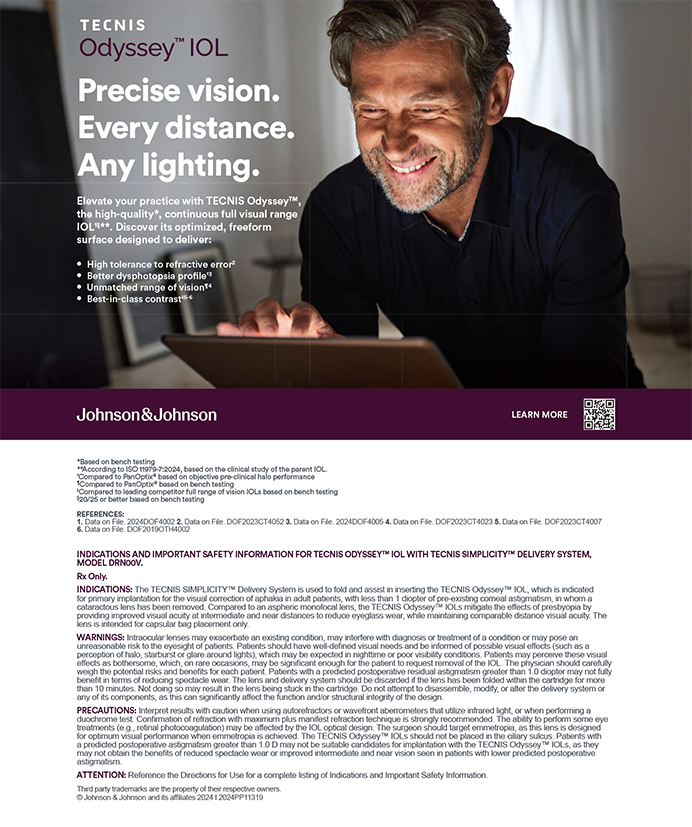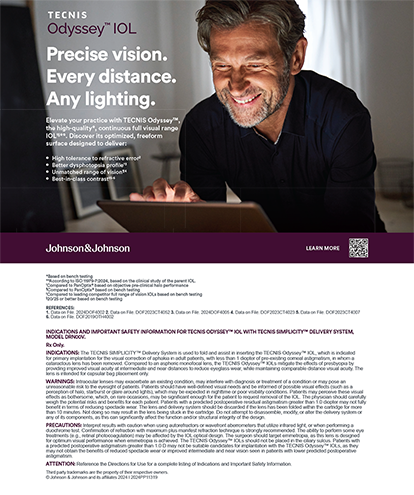An ideal ophthalmic viscosurgical device (OVD) would remain in the anterior chamber throughout phacoemulsification and then be easily and completely removed to eliminate postoperative increases in IOP. The OVD would protect the corneal endothelium from damage (from ultrasound power, lens fragments, heat, air bubbles, hydroxyl radicals, instruments, and the IOL), create space, flatten the anterior capsule prior to the capsulorhexis, deepen and maintain the chamber prior to phacoemulsification, and stabilize the iris and intraocular tissues. It would remain clear and free of bubbles, would not obstruct flow at the phaco tip (which can increase the risk of wound burns), would easily inflate the capsular bag, and would have rapid egress through the trabecular meshwork.
In brief, at different stages of the cataract procedure and at different flow rates, it is sometimes best to have an OVD with more dispersive, protective, coating properties (usually associated with a low viscosity and molecular mass). At other times, one needs an agent with more cohesive properties (ie, more viscous) to maintain space and be easily removed. I have found that, in a single syringe, Amvisc Plus (Bausch & Lomb, Inc., Rochester, NY) represents a satisfying combination of both dispersive and cohesive characteristics that facilitates phacoemulsification. Because of these viscoadaptive features, it has become my OVD of choice for routine cataract surgery.
RESEARCH RESULTS
Amvisc Plus is a 1.6% sodium hyaluronate product derived from rooster combs.1 Constituted with a lower-molecular-weight hyaluronic acid molecule (1.5 million Daltons) in a higher concentration than the original Amvisc (Bausch & Lomb, Inc.), Amvisc Plus has a higher zero-shear viscosity.
Comparative studies have shown no differences in postoperative corneal thickness, endothelial cell count or morphology, IOP, and visual acuity in eyes that underwent phacoemulsification with Amvisc Plus or Viscoat (Alcon Laboratories, Inc., Fort Worth, TX).1-3 Pair-wise comparisons showed a lower mean maximal IOP and a lower mean maximal change in IOP4 among eyes that underwent cataract surgery with Amvisc Plus versus Healon (Abbott Medical Optics Inc., Santa Ana, CA).
Amvisc Plus' cohesive/dispersive index of 21.4 is higher than that of Viscoat (3.4) or DisCoVisc (12) (Alcon Laboratories, Inc.) but significantly lower than that of Healon (31.2), ProVisc (46) (Alcon Laboratories, Inc.), and Healon GV (72.3) (Abbott Medical Optics Inc.).5 These differences are consistent with the clinical performance of Amvisc Plus as a viscoadaptive device. Similarly, the OVD has a midrange ability in scavenging free hydroxyl radicals.5
If an insufficient amount of Amvisc Plus remains in the anterior chamber intraoperatively, the cataract surgeon can easily reinject the OVD as needed during phacoemulsification with little risk of IOP spikes. The literature puts this statement in perspective. The percentage of eyes with an IOP higher than 30 mm Hg 24 hours after phacoemulsification was 6.1% with DisCoVisc,6 whereas in the study by Henry and Olander, no patients experienced a pressure spike of greater than 30 mm Hg at 24 hours with Amvisc Plus.7
In vitro studies have demonstrated that this OVD results in the lowest thermal increase generated during ultrasound compared with six other agents. The heat generated with each of these OVDs during ultrasound did not correlate with their rheological characteristics.8 These results may have implications for the minimization of the risk of wound burns during phacoemulsification.
CONCLUSION
Cataract surgeons generally agree that specific OVDs, such as Healon5 (Abbott Medical Optics Inc.), may be particularly useful in unusual clinical situations (eg, eyes with intraoperative floppy iris syndrome). For standard phaco cases, however, I have found that Amvisc Plus has high utility, affordability, and unique viscoadaptive rheologic features that facilitate routine phacoemulsification and the IOL's implantation.
Jay S. Pepose, MD, PhD, is a professor of clinical ophthalmology and visual sciences at Washington University School of Medicine and the director of the Pepose Vision Institute in St. Louis. He is a consultant to Bausch & Lomb. Dr. Pepose may be reached at (636) 728-0111; jpepose@peposevision.com.
- Probst LE, Nichols BD. Corneal endothelial and intraocular pressure changes with Amvisc Plus and Viscoat. J Cataract Refract Surg. 1993;19:725-730.
- Davis EA, Lindstrom RL. Corneal thickness and visual acuity after phacoemulsification with 3 viscoelastic materials. J Cataract Refract Surg. 2000;26:1505-1509.
- Moser CL, Martin-Baranera M, Garat M, et al. Corneal edema and intraocular pressure during cataract surgery. Randomized comparison of Healon 5 and Amvisc Plus. J Cataract Refract Surg. 2004;30:2359-2365.
- Poyer JF, Chan KY, Arshinoff SA. Quantitative method to determine the cohesion of viscoelastic agents by dynamic aspiration. J Cataract Refract Surg. 1998;24:1130-1135.
- Magueri F, Maltese A, Ward KW, Bucolo C. Hydroxyl radical scavenging activity of a new viscosurgical device. Curr Eye Res. 2007;32:105-111.
- DisCoVisc [package insert]. Fort Worth, TX: Alcon Laboratories, Inc.; 2007.
- Henry JC, Olander K. Comparison of the effect of four viscoelastic agents on early postoperative intraocular pressure. J Cataract Refract Surg. 1996;22:960-966.
- Floyd M, Valentine J, Coombs J, Olson RJ. Effect of incisional friction and ophthalmic viscosurgical devices on the heat generation of ultrasound during cataract surgery. J Cataract Refract Surg. 2006;32:1222-1226.


